|
About
the Goathead (Tribulus terrestris)
Let us start by discussing the goathead plant or puncture
vine,
bane of the cyclists existence. This small ground hugging annual
plant
produces a little seed with a protruding spike that one could
imagine
was created to puncture bicycle tires. Their affect on
cyclists is seasonal. They
are
worst in the late summer
and fall, when the plants have recently dropped their seeds. In the
spring many of the seeds decay and the robustness of the spines is
diminished. They also tend to be worse if we receive more than
average
summer rains. Areas that receive little motor vehicle traffic
tend have fewer goatheads, as they are propagated more by motor
vehicles than
bicycles or shoes. They also are more common at lower altitudes. On
rain soaked days (rare in NM) their spines become soggy and they
cease
to be a problem.
I
have observed that the goathead plants often have an ant bed at
their
base, always the tiny 3mm long ants. Perhaps the goathead protects
the
ants, and the ants loosen the soil for the plant. They have
pretty little yellow blossoms in the spring and early summer. The
plants are not native to the New World, and are thus relegated to
developed and urban areas,where they have been spread by vehicles.
Glass
In
addition, New Mexico has a bit of a littering/DWI problem, and
drivers, especially
those already inebriated, occasionally toss their glass beverage
bottles out
the window. This gets ground into little glass bits on the
side of
the road.
What
to do?
Tubeless tires:
Most cyclists nowadays use tubless tires. They seal the goathead
punctures pretty
well. The latex, in our warm dry climate, tends to dry out in the
tire
after a while,
and then it will no longer seal the punctures. Larger punctures and
sidewall tears will put you out of business though.
Slime or similar
sealant with clinchers:
This
works pretty well, but it works better if you have fitted or even
slightly oversized tubes. I use a 30mm tube in with a 26mm
tire
for training. If the tube is stretched, it is harder for the
sealant to work. This is a cheaper option that getting a tubless
setup.
You can inject sealant into most non-removable presta valve tubes
by unscrewing the little cap nut with a pair of pliers, and pushing
the
valve core though inside of the tube. An old spoke works well for
this.
The valve core will then be loose in the inside of the tube.
Ideally you can catch the valve core and pinch it
between your fingers while you squeeze the sealant in. If you need
an
extra hand you can usa a clothespin or better yet vise grips to hold
the core. If you lose the
core
entirely, you
can feel around inside the tube and find it eventually, but it is
kind
of a pain.
To reassemble, you push the core back into the inside of the
presta valve, then hold the tube
about 6 inches back from the valve and swing it it down to smack
onto a
workbench. This will usually force the core out enough that you
can start the cap nut back onto the core.
I
think Slime or other similar non letex sealants work better on
clinchers. Straight
latex or Stans sometimes does not work well with inner tubes, as it
tends to
squeeze
out between the tire and tube without sealing. Orange Seal is
supposed
to be better, I am testing it on some tubulars now. I have tried
some
mixes of Slime and Stans. It seems to work better, but maybe it is
just
my imagination. I had a friend who swore by a Slime/Stans
mixture in his tubeless tires. If you have more experience with
this, let me know.
Tubeless Tubulars:
The Czech
manufacturer Tufo makes tubless tubulars. Continental and Dugast
make
some too. They function as well as tubless tires as far as sealing
goathead holes goes. I think that the latex stays liquid longer in a
tubular than in a tubeless tire. You swap the hassle of seating
tubless
tires for the hassle of gluing tubulars. I used to train a lot on
21mm
Tufo
S33 pros. They
are about $40, and they now make them in a 24mm width. Tufo also
makes good cyclocross tubulars. Some
tread and sidewall punctures are irreparable as you cant really take
the tire apart to fix it. The tread compounds (particularly the non
black compounds) tend to dry and harden after a few years in out
desert climate, sometimes developing little cracks. For dry
cross
courses this does not seem to matter much.
Regular Tubulars with sealant:
This
works so-so. It depends on the tubular. Sometimes a hole
just won't seal. There seems to be some problem with Stans
degrading latex inner tubes, maybe Slime degrades them as well. I
have had pretty good luck with Vittoria cross tubulars and low end
Continental and Clement road Tubulars. I have a Dugast cross tubular
that
I can't get to seal. I have also had trouble getting FMB MTB
tubulars
to seal. I did get them to work for a while.
Sometimes
CX race tubulars will need quite a bit of sealant to resist courses
with goatheads. It is just tragic to add the weight to a nice
tubular, but it is better than getting a flat. I would not
dump a
full load of Stans in my road race tubulars, but small hole in a
race
tubular can often be fixed
with a little bit of latex.
"The System":
Note, this has become more of a history lesson than something people
are using now.
You can make your tires more or less flat proof
with a little work and an extra set of old tires. They will also be
pretty heavy
and ride a bit rough. Back in the day in NM pretty much all the
serious
racers had a pair of system wheels to train on. You could be
ridiculed for having a flat riding lighter non system wheels when
everyone else was riding on heavy system wheels, and they had to
stop
while you changed your tire. Basically you use
an old tire as a liner for a new one. I had a friend who used to use
a
22mm tubular tire stuck inside of a 25mm clincher for more or less
the
same effect. If you would like to try the system, Steve Matthias has
prepared the following step by step directions:
Items you will need.
1. Box cutter or sharp knife
2. Scissors (preferably a large, heavy pair)
3. Baby powder
4. A new set of tires
5. An old set of worn out tires (liner tires)
Note:It generally works best to use liner tires that are a size or
two
smaller than the tires they will go inside. So for example, if your
new
tires are 25c then try to use 23c or smaller tires as liners. I have
used the same size tires before, but it is harder to fit it all
together.
Step 1. Remove the beads from a pair of old worn out tires.
Use your box cutter to make a starter cut - large enough to get your
scissors through - in the sidewall of the liner tire. Depending on
the
model of the tire, half way down the sidewall, or ~3mm from the edge
of
the tread is a good place to cut.
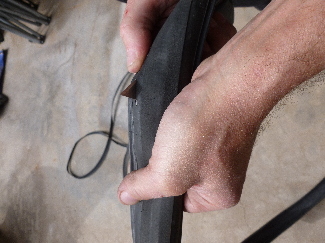 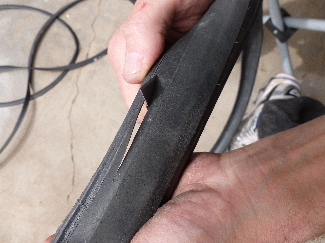
Next, use your scissors to cut all the way around the liner tire to
remove the bead.
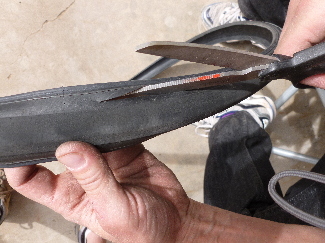 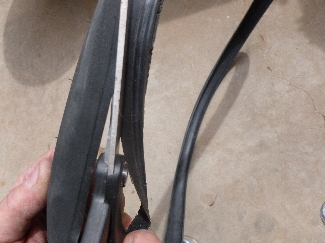
Repeat the steps above to remove the bead from the other side of the
liner tire.
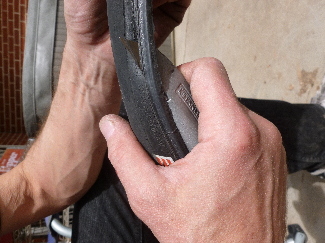 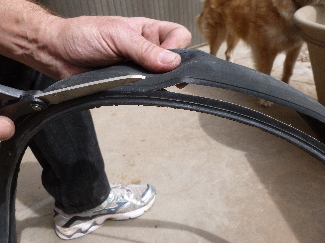
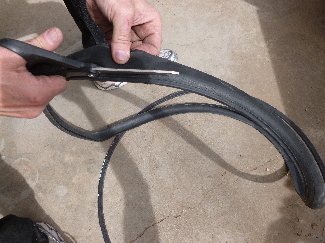 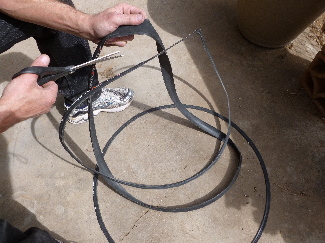
Check that there are no barbs or rough edges on your liners. If
there
are, try to remove them and ensure that the edges of your liners are
as
smooth as possible.
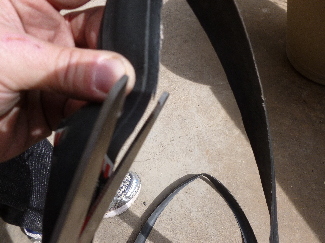 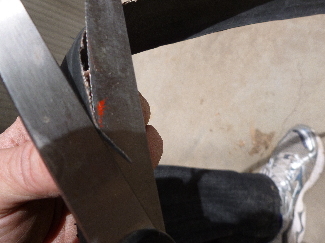
As should be obvious, repeat all the above steps so that you have
two
liners.
Step 2. Assembly
While not essential, coating your tubes, liners and the insides of
your
tires with baby powder will make getting all this rubber stuffed
together a lot easier. I also think that it improves the ride
quality
once you are out on the road.
First coat the inside of the tires with baby
powder.
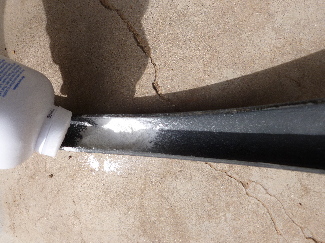 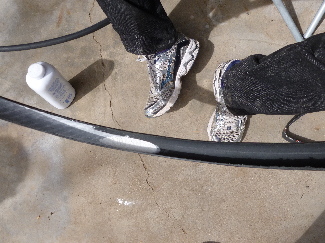
Then, insert the liners inside the
tires.
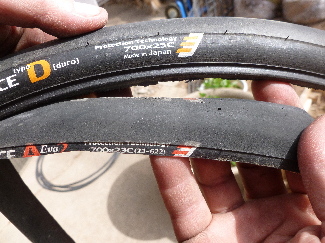
You can either try to coat the liners with baby powder before you
put
them in the tires, and/or coat the insides of the liners after they
are
inserted.
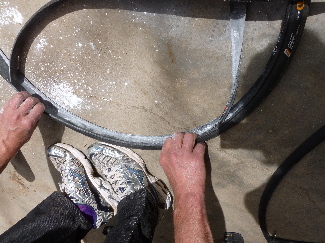 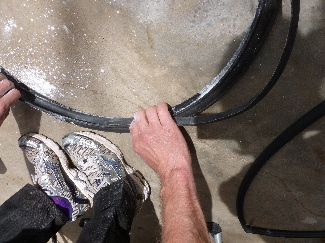
 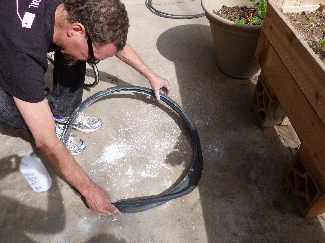
Finally, insert your tubes inside the tire/liner combinations and
mount
them on your
wheels.
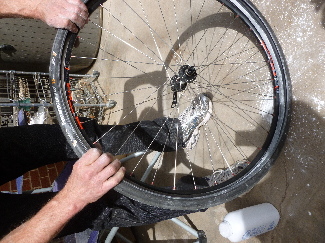 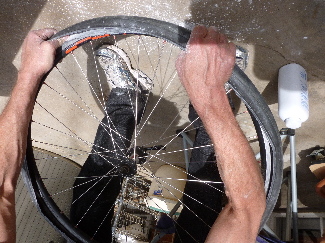
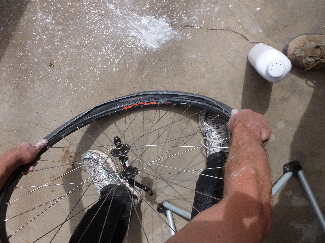 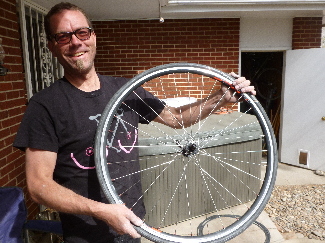
That's it! Put your wheels on your bike and go for a flat-free ride.
Be safe.
Addendum:
A few days after setting up this set
of system wheels, I was on a ride and hit a large bent rusty nail
that
went in the tire and out the sidewall. The tube was NOT punctured!
Unfortunately, there were some rather nasty gouges in my brake
caliper.
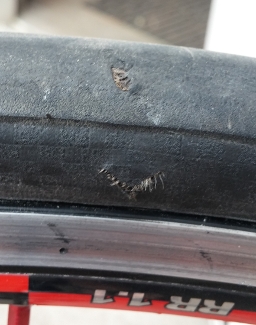
All photos © Jennifer Buntz
|








